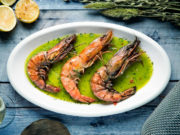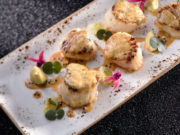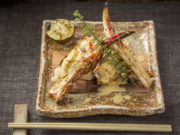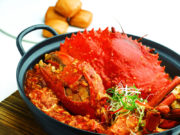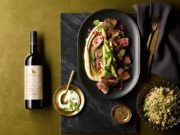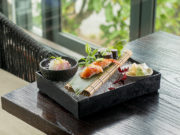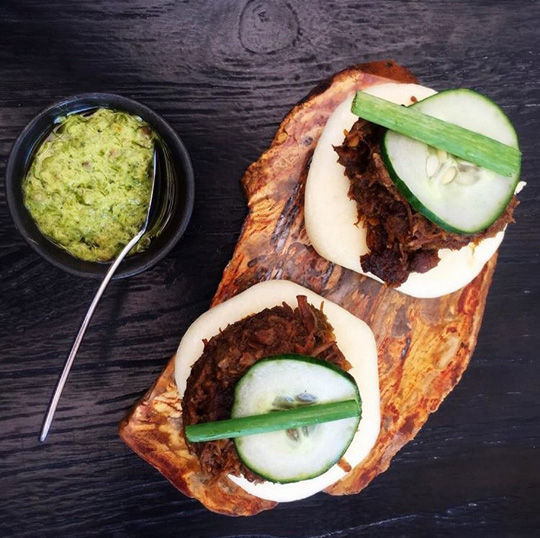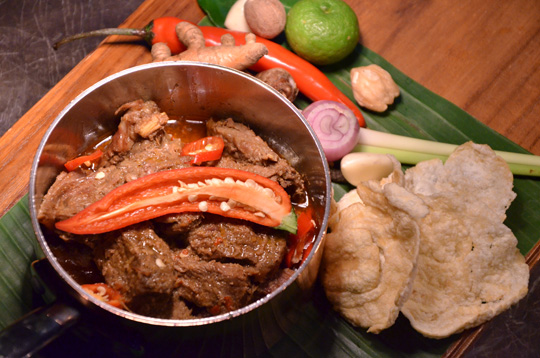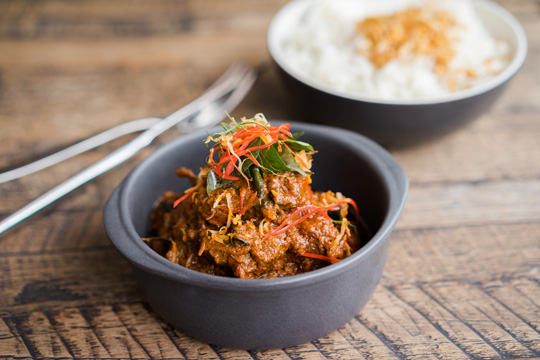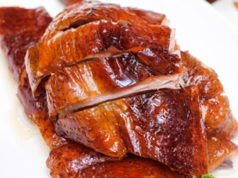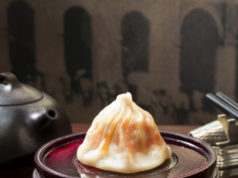The Minang Kabau people and their highly spiced cuisine have spread not only throughout Indonesia but into neighbouring countries such as Singapore and Malaysia. Rendang, one such gastronomic delight and perhaps their most famous, appears to be first mentioned in Hikayat Amir Hamzah, a Malay chronicle dated 1511, as a meal eaten on special occasions. Conventionally rendang uses coconut milk and beef as its core ingredients, but many variations using other protein-rich foods have evolved over the years. Like many of the most popular Indonesian dishes, it takes a long time to prepare before being slowly cooked, which intensifies the rich and spicy flavours of the chilli, pepper, spices, onion, turmeric leaves and lime leaves that infuse and coat the meat. Traditional rendang is dry, cooked until almost all the liquid is gone, leaving the meat coated in the spicy almost fibrous sauce. It is usually served with rice. Wet rendang, or kalio, is similar but cooked for a shorter period so the liquid does not evaporate, meaning the meat is served in a thick, succulent spicy sauce.
–
Merah Putih
Celebrating Indonesia’s finest cuisine, culture, craftsmanship and people, Merah Putih is perhaps Bali’s most famous high-end Indonesian restaurant and refines the region’s classics. Easily the most popular dish on its ever-changing menu is the beef rendang, and for good reason, too. It transforms this traditional signature into sumptuous gourmet bites, using imported beef shanks that are simmered in a Sumatran coconut milk curry for hours until tender. The rich, juicy, marinated meat is then served over homemade steamed buns with some pickled cucumbers and green chill sambal for a typical Indonesian kick.
–
Tamarind Kitchen & Lounge
At Tamarind, the signature restaurant of the Nusa Dua Beach Hotel & Spa, the menu’s Indonesian delicacies are designed to celebrate the true flavours of the archipelago. Doing exactly that, the signature beef rendang is traditionally slow-cooked and spiced using all the right ingredients. Over 20 different local spices, roots, herbs and vegetables, including lemongrass, galangal, ginger, cinnamon, shallots and kaffir lime leaves, are ground by hand in a mortar and pestle to help flavour fine chunks of beef that are then simmered over hours in fragrant coconut milk and served with aromatic jasmine rice and traditional condiments. Tamarind is headed by young and talented Indonesian chef, Widi Arguno, who regularly travels all over the world to explore the secrets behind local ingredients.
(www.tamarindrestaurantbali.com)
–
Tiger Palm
Created by Indonesia’s famed “Street Food Chef” Will Meyrick, the Kandar Beef Rendang at Tiger Palm is not only an honourable celebration of Indonesia’s beloved delicacy, but is also testament to Chef Will’s renowned culinary approach: to bring generations-old recipes and authentic cooking techniques to the dinner table using refined, premium ingredients. Unsurprisingly so, the Kandar Beef Rendang is one of Tiger Palm’s most popular dishes, truly representing Southeast Asia’s melting pot of regional cultures. Balancing traditional ingredients in one scrumptious, slow-cooked stew, the recipe sees succulent beef tenderised over hours in black soy to give the sauce its darkness and subtle umami tang, whilst a little fenugreek, galangal, turmeric, ginger, lemongrass and coconut milk infused with curry leaves gives the dish its rich and spiced creaminess that works in textural harmony with wood-steamed, Kandar-style rice served alongside. Cultural, culinary perfection.







